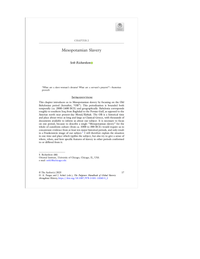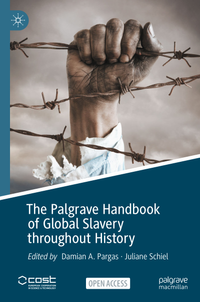Seth Richardson describes Mesopotamian slavery.
- Type
- Book
- Source
- Seth Richardson Non-LDS
- Hearsay
- Secondary
- Reference
Seth Richardson, "Chapter 2: Mesopotamian Slavery," The Palgrave Handbook of Global Slavery throughout History ed. Damian Pargras and Juliane Schiel (Palgrave MacMillan: Cham, Switzerland, 2023) 17-39
- Scribe/Publisher
- Palgrave MacMillan
- People
- Seth Richardson
- Audience
- Reading Public
- Transcription
“What are a slave-woman’s dreams? What are a servant’s prayers?”—Sumerian proverb
Introduction
This chapter introduces us to Mesopotamian slavery by focusing on the Old Babylonian period (hereafter, “OB”). This periodization is bounded both temporally (ca. 2000–1600 BCE) and geographically: Babylonia corresponds roughly to southern Iraq from Baghdad to the Persian Gulf, as opposed to the Assyrian north near present-day Mosul/Kirkuk. The OB is a historical time and place about twice as long and large as Classical Greece, with thousands of documents available to inform us about our subject. It is necessary to focus on one period, because to describe a single “Mesopotamian slavery” for the whole of cuneiform culture (from ca. 3300 to 300 BCE) would require us to concatenate evidence from at least ten major historical periods, and only result in a Frankenstein image of our subject. I will therefore explain the situation in one time and place which typifies the subject, but also try to give a sense of where, when, and how specific features of slavery in other periods conformed to or differed from it.
OB slavery was primarily a mechanism to provide credit in an emerging mercantile economy—which otherwise had few if any stable financial institu-tions—rather than to satisfy labor needs in any other productive sector. It was primarily in this way that Mesopotamian slavery had globalizing effects: merchants, slaves, and transacted values moved through local, regional, and supra-regional trading networks: trafficked slaves were moved to what is now southern Iraq from places of origin as much as 1000 km away which are now in Turkey, Syria, and Iran. This has implications for language and cultural contact, but the most durable consequence was the transmission of the socio-economic practice of using people as a form of capital. The trade in slaves began to establish homologies of prices, systems of credit, legal standards, and even concepts of personhood throughout the Near East.
The OB period was the age of Hammurabi, a time characterized politically by competition and conflict between many small territorial states; socially, by an emerging class of private householders and merchants; and economically by credit markets and great trading networks connecting Mesopotamia to the Mediterranean, Anatolia, Elam, and the Persian Gulf, with contacts extending to Oman and the Indus Valley. It is a period with a well-rounded range of sources for slavery, with evidence from law codes and lawsuits, letters and contracts, proverbs and bequests. These diverse text types all have their own conventions and limitations, but they allow us to build a portrait of slavery as a social, legal, and economic institution and even of the experiences of individual slaves and masters.
These records reveal the basic socio-economic contours of OB slavery. Some slaves were born into status (i.e., “house-born”); others were brought from foreign places. Some slaves eventually “integrated” into their masters’ families by adoption, inheritance, or marriage; some formed families of their own. Slaves could own moveable property; some were literate; they had the capacity to give legal testimony.6 Households which owned slaves generally had only one or two. Slaves and masters knew each other face-to-face as indi-viduals, and slaves were virtually always referred to by name. They performed housework and field labor, but no type of work which was not also done by non-slaves. They were trusted with a wide range of tasks which required their free movement (even unguarded travel to other cities), independent judgment, and personal knowledge of their masters’ affairs. They acted as legal and business proxies for their masters, and their reputations reflected on their households. Yet these positive indications of personhood are tempered by other features. Slaves were bought and sold as chattel much like oxen and commodities. They were commonly used as pawns to establish commercial credit, and a variety of mechanisms existed to control their movement and behavior, including community surveillance and force. Slaves were required to wear distinctive hairstyles and perhaps garments, partially isolating them from their previous social identities, and they were “genealogically isolated” by the limited possibilities to pass on their names as patronyms, though this was not forbidden.
This mixture of adverse and positive attributes, broadly accurate for slavery in all periods of Mesopotamian history, requires us to ask where to inscribe the boundaries of “social death." The social death that characterizes slavery cross-culturally, according to Orlando Patterson, entails the loss of name and identity, punishment by death for flight, and the rejection of the slave as a member of society. But Babylonian slavery, in its particular admixture of social recognitions and subordinations, does not meet all these criteria.
It must be stressed that we have no clear semantic or etymological understanding of the various Sumerian and Akkadian words for “slave” (either masculine or feminine) and “slavery.” This is a complicated matter which cannot be addressed in full here but suffice it to say that although some proposed meanings are hardly impossible, they are neither linguistically clear nor as logical as they first appear. For instance, Sumerian arad and Akkadian ardu for “slave” might connote foreignness on etymological and even graphemic grounds (as “mountain man” or “(one) brought down (the river?).” But the etymons are neither certain nor even semantically exclusive in either case, and even the logical premises are complicated by the fact that both words were routinely applied to “slaves” who were clearly not foreign at all but (former) citizens of the same city. We can also exclude the idea that racial or ethnic identity was imbued in the Mesopotamian terms, as “Slav” is within “slave.” The point is that any translation of “slave” for Mesopotamian terms (including as I use it here) is purely conventional, and possibly anachronistic and plain old wrong.
All of this introduces us to the central problem and paradox of Mesopotamian slavery: the disposition of persons whom we identify in socioeconomic terms as “slaves” because they were legally and commercially chattel, but who nevertheless had both agency and specific social and legal identities. Thus, even the evidence from this earliest of literate world cultures requires us to question how foundational slavery really was and the degree to which it compromised or erased personhood. Should we understand this Babylonian slavery to be para-social, in which a degree of personhood was conferred on slaves, at least to the minimum extent necessary to deputize them as effective proxies for their masters? Or should we think of that very construction as slavery’s most fundamental hypocrisy, to create a class of persons who could be “trusted” to perform as many roles as free persons without recognizing and permitting basic control over their bodies, places of residence, and life choices? No less urgent are the questions for the slaveholding society itself: how did the institution, practices, and individual slaves affect what it meant to be a Babylonian who was not enslaved?
....
The B. H. Roberts Foundation is not owned by, operated by, or affiliated with the Church of Jesus Christ of Latter-day Saints.



